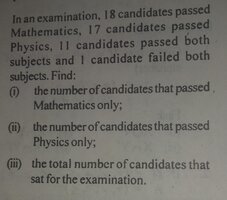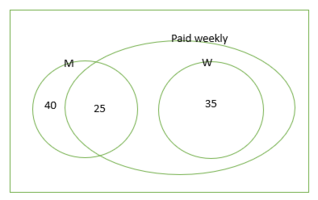You are using an out of date browser. It may not display this or other websites correctly.
You should upgrade or use an alternative browser.
You should upgrade or use an alternative browser.
Are these venn diagrams correct for the problem?
- Thread starter chijioke
- Start date
- Joined
- Feb 4, 2004
- Messages
- 16,582
I am interested in knowing whether the venn diagrams are correctly drawn for each of the problems.
1.View attachment 36334
View attachment 36338
Assuming that "M" means "the number of men", "W" means "the number of women", and the overlap means "those who are paid weekly", you appear to have all 100 persons being male. Sixty men are paid weekly, and the other forty men are not.
Does this match the exercise?
This Venn diagram looks good.
No. It doesn't. I am looking at it that venn diagram cannot be drawn for this kind of problem. What do you think?Assuming that "M" means "the number of men", "W" means "the number of women", and the overlap means "those who are paid weekly", you appear to have all 100 persons being male. Sixty men are paid weekly, and the other forty men are not.
Does this match the exercise?
This Venn diagram looks good.
Last edited:
Dr.Peterson
Elite Member
- Joined
- Nov 12, 2017
- Messages
- 16,619
First problem:


I'm guessing that M means Men and W means Paid Weekly. Is that right? You must define your labels! (But what does [imath]\mu=100[/imath] mean?) If so, then women constitute everything outside the M loop, and those outside both loops are women who are not paid weekly (of which there are none).
(If M were Men and W were Women, you'd be saying that 60 people are both, which I'm sure you can't mean.)
Your diagram seems to say that there are 100 men (wrong), and that 60 of them, and no women (wrong) are paid weekly; it doesn't represent the fact that there are 65 men, or that all women are paid weekly.
Second problem:
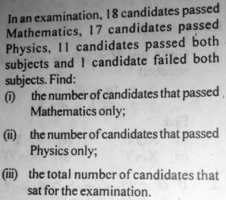
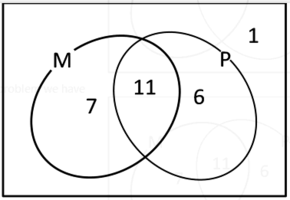
This, as you've been told, is correct, assuming that M means "passed Mathematics" and P means "passed Physics"). I presume you can answer the questions from it.


I'm guessing that M means Men and W means Paid Weekly. Is that right? You must define your labels! (But what does [imath]\mu=100[/imath] mean?) If so, then women constitute everything outside the M loop, and those outside both loops are women who are not paid weekly (of which there are none).
(If M were Men and W were Women, you'd be saying that 60 people are both, which I'm sure you can't mean.)
Your diagram seems to say that there are 100 men (wrong), and that 60 of them, and no women (wrong) are paid weekly; it doesn't represent the fact that there are 65 men, or that all women are paid weekly.
Second problem:


This, as you've been told, is correct, assuming that M means "passed Mathematics" and P means "passed Physics"). I presume you can answer the questions from it.
Why do you think it can't be drawn? And which problem are you referring to?No. It doesn't. I am looking at it that venn diagram cannot be drawn for this kind of problem. What do you think?
Harry_the_cat
Elite Member
- Joined
- Mar 16, 2016
- Messages
- 3,760
I have tried every manipulative skill to come up with a venn diagram suitable for the problem and yet nothing is fitting the problem as it is.Why do you think it can't be drawn? And which problem are you referring to?
W means the set of women.First problem:
View attachment 36342
View attachment 36343
I'm guessing that M means Men and W means Paid Weekly. Is that right? You must define your labels!
It means all the men and women.(But what does [imath]\mu=100[/imath] mean?)
Yes.(If M were Men and W were Women,
If 65 are men, then 35 would be women. All the 35 men and 25 women are paid weekly. So how do represent this in a Venn diagram or is it this not representable?you'd be saying that 60 people are both, which I'm sure you can't mean.)
Your diagram seems to say that there are 100 men (wrong), and that 60 of them, and no women (wrong) are paid weekly; it doesn't represent the fact that there are 65 men, or that all women are paid weekly.
I have no issue with the second problem as it has been confirmed that it looks good. My focus is now on first problem.Second problem:
View attachment 36344
View attachment 36345
This, as you've been told, is correct, assuming that M means "passed Mathematics" and P means "passed Physics"). I presume you can answer the questions from it.
Why do you think it can't be drawn? And which problem are you referring to?
This is excellent. I love this.View attachment 36346
To answer the question, a Venn diagram is not needed.
1. If there are 100 people and 65 are men, how many are women?
2. If 60 people are paid weekly, including all the ?? women, how many men are paid weekly?
A Venn diagram could look like:
View attachment 36347
where M is men and W is women.
Please if you have link where there are examples on various ways venn diagram can constructed please don't keep it away from me.
Dr.Peterson
Elite Member
- Joined
- Nov 12, 2017
- Messages
- 16,619
But then you have no representation of "paid weekly".I have tried every manipulative skill to come up with a venn diagram suitable for the problem and yet nothing is fitting the problem as it is.
W means the set of women.
If 65 are men, then 35 would be women. All the 35 men and 25 women are paid weekly. So how do represent this in a Venn diagram or is it this not representable?
The M loop contains men; everything outside it is women. You don't need a separate loop for them.
If we call the W loop "paid weekly", then we can do this:
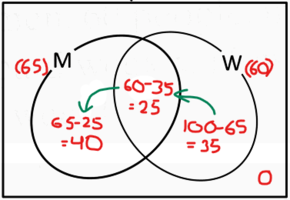
There is are no women not paid weekly; so all the women (100 people - 65 men = 35 women) are paid weekly; then the rest of those paid weekly (60 - 35 = 25) are men who are paid weekly; and finally, the rest of the men (65 - 25 = 40) are not paid weekly.
This is a clearer diagram than the other. in my opinion.
I appreciate the venn diagram but you did not label the rectangle which I suppose should be the universal set = 100.But then you have no representation of "paid weekly".
The M loop contains men; everything outside it is women. You don't need a separate loop for them.
If we call the W loop "paid weekly", then we can do this:
View attachment 36348
There is are no women not paid weekly; so all the women (100 people - 65 men = 35 women) are paid weekly; then the rest of those paid weekly (60 - 35 = 25) are men who are paid weekly; and finally, the rest of the men (65 - 25 = 40) are not paid weekly.
This is a clearer diagram than the other. in my opinion.
Dr.Peterson
Elite Member
- Joined
- Nov 12, 2017
- Messages
- 16,619
Yes, I trusted that you knew that. If I deliberately cut off [imath]\mu=100[/imath], it would be because I'm not sure whether somehow [imath]\mu[/imath] means "size of universal set", and I didn't want to confuse things. (And you didn't label the universal set in your other diagram, so I take it to be optional.)I appreciate the venn diagram but you did not label the rectangle which I suppose should be the universal set = 100.
Now suppose I decide to give the information set notation, then this is what we expect:Yes, I trusted that you knew that. If I deliberately cut off [imath]\mu=100[/imath], it would be because I'm not sure whether somehow [imath]\mu[/imath] means "size of universal set", and I didn't want to confuse things. (And you didn't label the universal set in your other diagram, so I take it to be optional.)
n(M)=65 _total number of men)
n(MnW)=25_ meaning 25 men are working weekly and 25 women are working weekly as well)
n(M'nW) = 35 means...
Would I be right to say 35 represent all the women who are working weekly? Remember you said that N={ workers working on weekly basis including men and women}
Dr.Peterson
Elite Member
- Joined
- Nov 12, 2017
- Messages
- 16,619
Yes, since M has been defined as the set of men.n(M)=65 (total number of men)
I'm assuming you're using my definitions of M and W, not yours; namely M = set of men, W = set of people who are paid weekly.
No. The set [imath]M\cap W[/imath] is the set of people who are both men and paid weekly, that is, the set of men who are paid weekly. It says nothing about women.n(MnW)=25 (meaning 25 men are working weekly and 25 women are working weekly as well)
Note: not working weekly, but paid weekly.
If you were using your definitions, with W = set of women, then [imath]M\cap W[/imath] would be the set of people who are both man and woman, which is empty.
Yes, with small corrections. This is the number of women who are paid weekly.n(M'nW) = 35 means...
Would I be right to say 35 represent all the women who are working weekly? Remember you said that N={ workers working on weekly basis including men and women}
I said nothing about N, but, since M is the set of men, M' is the set of non-men, which we are presuming means women. (We aren't distinguishing children, for example.)
YesYes, since M has been defined as the set of men.
I'm assuming you're using my definitions of M and W, not yours; namely M = set of men, W = set of people who are paid weekly.
Just an opportunity to correct my self using your diagram.No. The set [imath]M\cap W[/imath] is the set of people who are both men and paid weekly, that is, the set of men who are paid weekly. It says nothing about women.
Note: not working weekly, but paid weekly.
If you were using your definitions, with W = set of women, then [imath]M\cap W[/imath] would be the set of people who are both man and woman, which is empty.
Yes, with small corrections. This is the number of women who are paid weekly.

Would I be right to say 35 represent all the women who are paid weekly? Remember you said that W={ workers paid on weekly basis including men and women}
So what would you use to denote the number of men and women paid on weekly basis. Remember you did not give any label for women paid on weekly basis.
Dr.Peterson
Elite Member
- Joined
- Nov 12, 2017
- Messages
- 16,619
Yes. The 35 is [imath]n(M'\cap W)[/imath], the number of women (i.e non-men) who are paid weekly.Would I be right to say 35 represent all the women who are paid weekly? Remember you said that W={ workers paid on weekly basis including men and women}
That would be W! That's all people who are paid weekly.So what would you use to denote the number of men and women paid on weekly basis. Remember you did not give any label for women paid on weekly basis.


